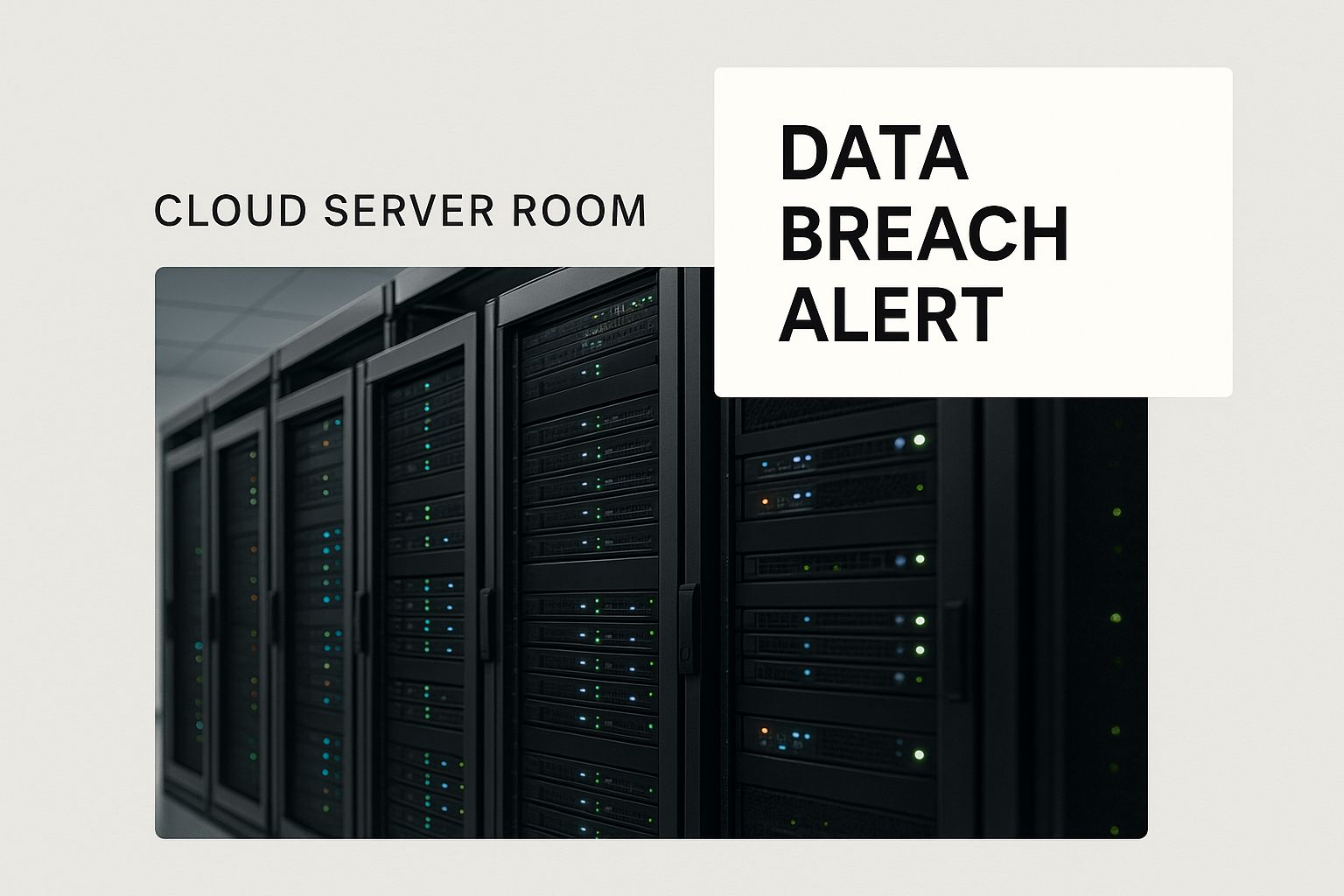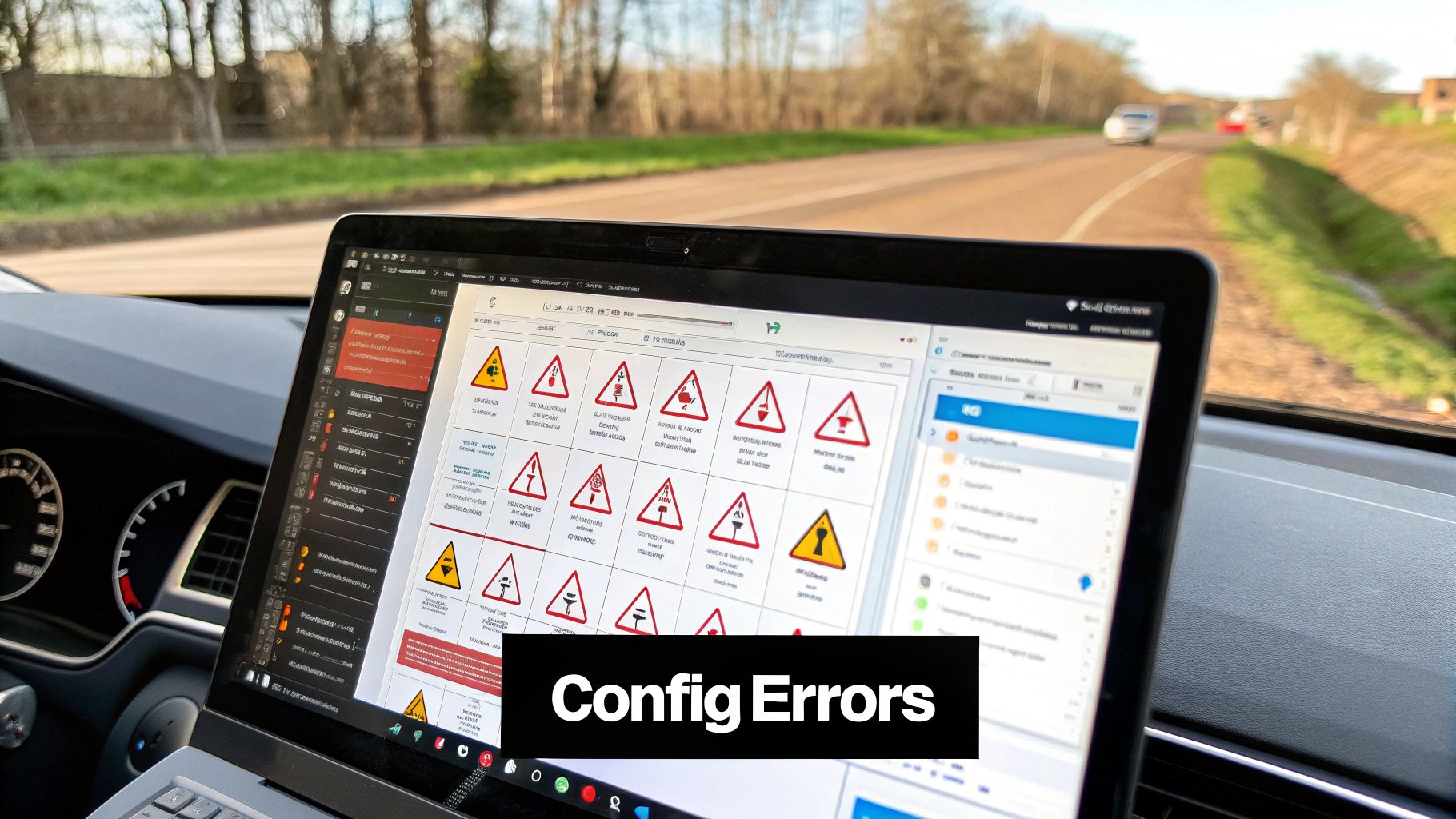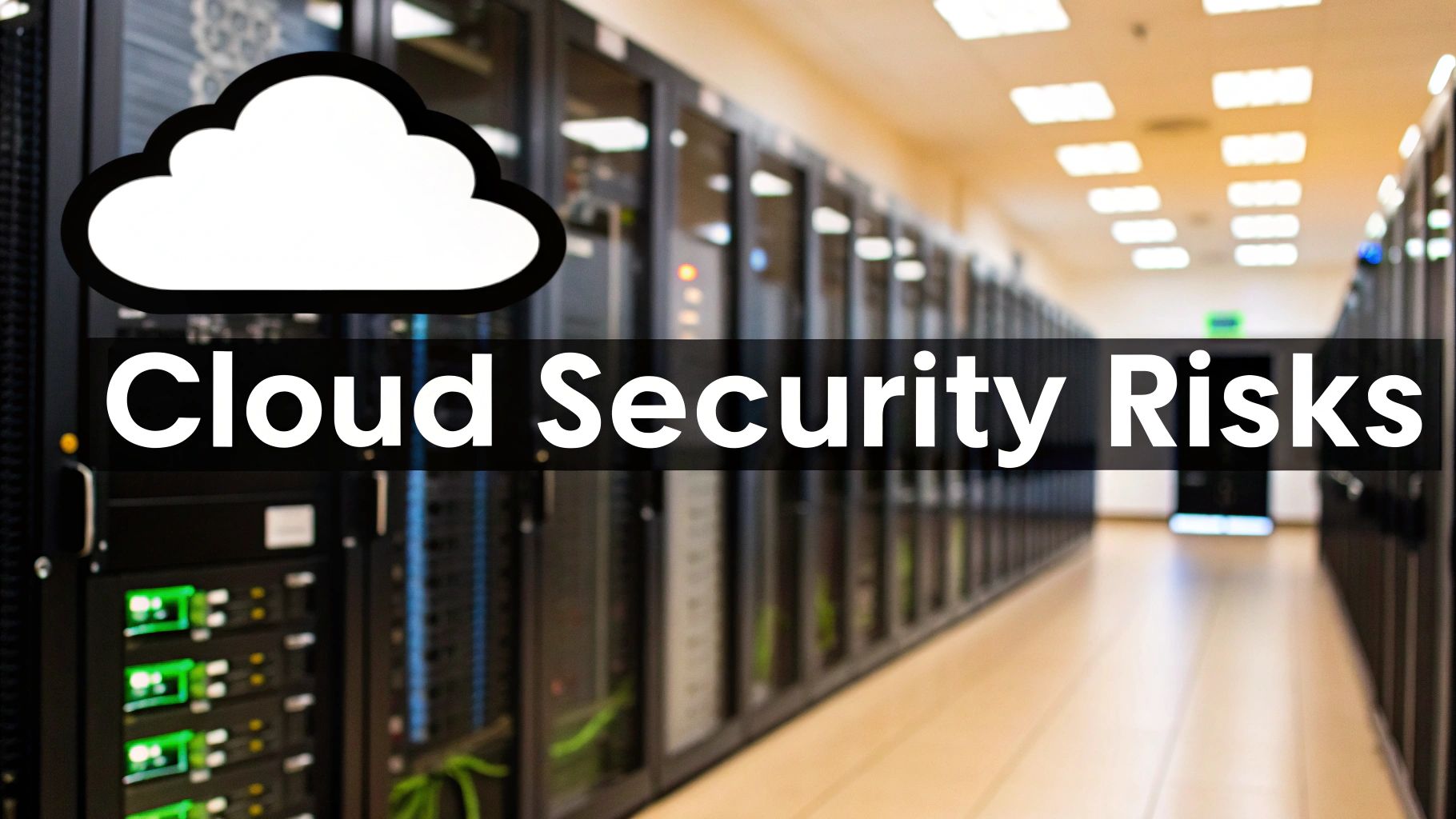Navigating the world of cloud computing can feel like a game-changer for any business, but it comes with its own set of serious security challenges. We're talking about everything from data breaches and accidental misconfigurations to failing to meet compliance rules. It's a common misconception that once you move to the cloud, security is handled for you. The reality is a bit more complicated. While cloud providers secure their global infrastructure, the responsibility for protecting what you put inside it falls squarely on your shoulders.
Understanding Today's Cloud Security Threats
So, why has cloud security become such a hot topic for businesses? The simple answer is that the way we operate has completely transformed. Company data, once tucked away safely on-site, is now spread across countless online services. This distributed model creates a whole new attack surface that needs to be managed properly.
A helpful analogy is to think of it like renting a flat in a top-tier, high-security building. The landlord—your cloud provider like Amazon Web Services or Microsoft Azure—takes care of the building's overall security. They install reinforced doors, run CCTV, and hire security guards. But you are still the one responsible for locking your own front door, deciding who gets a spare key, and making sure your windows aren't left wide open.
At the heart of this is the Shared Responsibility Model. The provider secures the cloud (the physical data centres, hardware, and core network), while you, the customer, secure everything in the cloud. This includes your data, applications, user access policies, and system configurations. Getting this division of labour wrong is probably the single biggest cause of cloud security incidents today.
The Scale of the Challenge in the UK
This isn't just a theoretical problem; it's a very real and present danger for organisations across the UK. The latest UK Cyber Security Breaches Survey painted a stark picture, revealing that around 43% of UK businesses had suffered a cyber breach or attack in the last year. These figures highlight just how active the threat is, with phishing and ransomware leading the charge. For a deeper dive into these UK-specific trends, Trustwave’s analysis offers some great insights.
To help make sense of it all, we can group the main risks into three key areas that every business needs to get a handle on.
Before we dive into the details of each threat, here's a quick look at the major risks and how they can impact your business.
Quick Overview of Top Cloud Security Threats
| Threat Category | Description | Primary Business Impact |
|---|---|---|
| Data Breaches | Unauthorised access to sensitive data, often through compromised credentials, insecure APIs, or system vulnerabilities. | Financial loss, reputational damage, and loss of customer trust. |
| Misconfigurations | Human error leading to security gaps, like public storage buckets, overly permissive access rights, or weak passwords. | Creates easy entry points for attackers, potentially leading to widespread system compromise. |
| Compliance Failures | Failing to adhere to data protection regulations like GDPR due to inadequate security controls in the cloud. | Hefty regulatory fines, legal action, and being barred from certain markets. |
This table gives you a snapshot, but it's crucial to understand the "how" and "why" behind each one. Let's start breaking them down.
Our aim here is to give you a clear and practical guide to this landscape. By getting to grips with these core ideas, you can start building a robust defence for your organisation's most valuable digital assets.
The 7 Cloud Security Threats That Matter Most
Knowing the general categories of cloud security risks is a good start, but to build a truly solid defence, you need to get specific. It's time to move past vague warnings and dive into the actual, tangible threats your business is likely to face. These aren't just abstract concepts; they're real dangers with costly consequences.
Let's break down the seven most significant security threats in the cloud. We'll look at what each one means in practice, so you can spot the signs and know exactly what you’re up against.
This image shows how even a physically secure server room can't stop a digital data breach, which often starts with a simple human error.

The image drives home the point that a data breach alert bypasses all physical security. The real threats in the cloud are almost always digital, not physical.
1. Cloud Misconfiguration
This is, without a doubt, one of the most common and damaging risks out there. A cloud misconfiguration is simply a security gap caused by human error, where someone on your team fails to set up or maintain a secure cloud setting.
Think of it as accidentally leaving the back door of your digital office wide open.
A classic example is an Amazon S3 storage bucket full of sensitive customer information being set to "public" instead of "private". This single mistake can expose thousands, or even millions, of records to anyone with an internet connection. In fact, some studies suggest that over 80% of all cloud data breaches can be traced back to these simple, preventable errors.
2. Data Breaches and Data Loss
While misconfigurations are a huge cause, data breaches can happen in many other ways. A data breach is when an unauthorised person gets their hands on your sensitive data. Data loss, on the other hand, is when that data is permanently wiped or made unusable, often due to ransomware or an accidental deletion.
The fallout is always severe, leading to huge financial penalties under regulations like GDPR, lasting damage to your reputation, and a total loss of customer trust. Imagine a cybercriminal using stolen employee login details (bought on the dark web) to access your cloud environment and walk away with your entire customer database. The average cost of a data breach is now well into the millions of pounds, making prevention an absolute must.
3. Insecure APIs
Application Programming Interfaces (APIs) are the glue holding the cloud together, letting different apps and services talk to each other. They're incredibly useful, but they also create a whole new frontier for attacks. An insecure API is like an unguarded service entrance that lets someone walk right past your main security desk.
Key Insight: An API that isn't set up with proper authentication can allow attackers to simply request sensitive data and get it. If an API key is leaked or just isn't changed for years, it becomes a permanent, hidden backdoor for criminals.
The infamous Facebook-Cambridge Analytica scandal was a perfect example of this. A third-party app's API was exploited to harvest the personal data of millions of users without their consent, showing just how dangerous a poorly secured API can be.
4. Account Hijacking
Account hijacking—or credential theft—is a straightforward but devastatingly effective attack. Criminals use a variety of tricks to steal the login details of a legitimate user. Once they're in, they can pose as that person to access systems, steal data, or launch even more attacks from inside your network.
Their common methods include:
- Phishing: Deceptive emails that trick users into giving up their passwords.
- Malware: Keyloggers or other malicious software that secretly captures login details as they're typed.
- Credential Stuffing: Using bots to try huge lists of stolen passwords from other breaches, hoping to find a match.
Making multi-factor authentication (MFA) mandatory is one of the most powerful ways to stop this. It requires a second proof of identity (like a code from a mobile app) that an attacker almost certainly won't have.
5. Insider Threats
Not all threats come from shadowy hackers on the other side of the world. An insider threat comes from someone already inside your organisation—an employee, a contractor, or even a trusted business partner who has legitimate access. These threats fall into two camps.
- Malicious Insider: A disgruntled employee who deliberately steals or deletes company data for revenge or personal gain.
- Accidental Insider: A well-meaning employee who unintentionally exposes data by clicking a phishing link, misconfiguring a cloud service, or losing a company laptop.
Building a strong security-aware culture through regular training is vital. For more focused tactics on protecting your cloud productivity tools, you can learn more about Office 365 cyber security and how to guard against both internal and external threats.
6. Denial-of-Service Attacks
A Denial-of-Service (DoS) attack is a brute-force attempt to make a system unavailable to its intended users. The goal is to flood your systems with so much junk traffic that they grind to a halt.
In a cloud setting, this could mean swamping your web application with so many requests that it crashes, cutting off access for your customers and bringing your business to a standstill. These attacks can be used to cause direct financial harm or, more cunningly, as a smokescreen to distract your security team while another attack, like data theft, happens unnoticed.
7. Compliance Violations
Finally, one of the biggest risks has nothing to do with hackers. Failing to follow data protection laws like GDPR can be just as catastrophic. The cloud adds new layers of complexity to compliance, as you have to ensure both your own setup and your provider's services meet strict legal standards.
A violation can result in eye-watering fines, legal action, and even being banned from doing business in certain countries. It's a business risk just as much as it is a technical one.
Pinpointing the Real Causes of Cloud Vulnerabilities
When a security breach hits the news, it’s tempting to picture shadowy hackers using impossibly complex techniques. The reality, though, is usually far less glamorous and much closer to home. Most cloud computing security risks don't just appear; they grow out of simple human error, process gaps, and a fundamental lack of clarity.
The single biggest issue I see time and time again is a misunderstanding of the Shared Responsibility Model. We've touched on this, but it’s worth repeating: your cloud provider secures their global infrastructure—the physical data centres, the servers, the core networking. They are responsible for the security of the cloud. But they don't manage your data, your user accounts, or the applications you build. That part is entirely on you. Failing to fully grasp where their job ends and yours begins is the source of countless security headaches.

This confusion isn't a minor problem. In fact, it's alarmingly widespread. Cloud security incidents remain incredibly common, with statistics showing that 81% of organisations faced at least one in the past year. A huge contributing factor is the number of neglected, public-facing assets out there. A staggering 84% of organisations have at least one, and 81% of those assets have open ports that are prime targets for attackers.
The Problem with a Single Master Key
A perfect illustration of this responsibility gap is weak Identity and Access Management (IAM). Think of it like this: you own a large office building. Instead of giving the marketing team a key just for their floor and the finance team a key only for theirs, you give every single employee a master key that unlocks every door. It sounds absurd, but that's precisely what happens in the cloud.
This is what we see when businesses grant excessive permissions to user accounts. An employee who only needs to view reports might be given full administrator access, meaning they could accidentally delete a critical database.
This approach, known as failing to implement the "principle of least privilege," creates a massive and completely unnecessary risk. If just one of those "master key" accounts is compromised, an attacker doesn't just get into one small room—they get the keys to the entire kingdom.
Inadequate Team Training and Awareness
Another major source of vulnerability is a lack of ongoing team training. At the end of the day, your employees are your first and last line of defence. If they aren't trained to recognise threats, they can unknowingly hold the door open for attackers.
This is especially true when it comes to social engineering. For example, a well-crafted phishing email can easily trick an employee into giving up their login credentials. Without proper awareness training, a team member might see an urgent-looking email from "IT," click a malicious link, and hand over their "master key" without a second thought. Our detailed guide offers practical advice on protecting against phishing email scams, a vital skill for every employee.
Effective training isn't a one-off event. It should cover:
- Spotting Phishing Attempts: Learning to identify fake emails, suspicious links, and urgent requests for sensitive information.
- Secure Password Practices: Enforcing the use of strong, unique passwords and, crucially, multi-factor authentication (MFA).
- Understanding Data Handling Policies: Knowing what data is sensitive and how it should be stored and shared securely in the cloud.
The Hidden Complexities of Multi-Cloud Setups
Finally, as businesses grow, many adopt a multi-cloud strategy, using services from different providers like AWS, Azure, and Google Cloud at the same time. While this brings flexibility, it also massively increases complexity and the potential for security gaps to form between platforms.
Each cloud has its own unique security tools, interfaces, and ways of doing things. Trying to manage security consistently across all of them is a serious challenge. A setting that is secure by default in one provider’s environment might be a glaring vulnerability in another.
Without a unified strategy for management and monitoring, it's incredibly easy to lose track of security policies. This creates inconsistencies that attackers are quick to find and exploit. This patchwork of different security models means misconfigurations can easily slip through the cracks, leaving parts of your digital estate exposed. Tackling these root causes—human error, process gaps, and complexity—is always the first step toward building a truly robust cloud defence.
Your Blueprint for Proactive Cloud Defence
Knowing the risks is one thing; building a solid defence is another entirely. It’s time to move from theory to action. A proactive approach isn't about having one single, unbreakable wall. It's about creating layers of security that work together, much like a modern fortress. Think of it as having strong outer walls, vigilant watchtowers, and well-trained guards on patrol. If an attacker breaches one layer, another is ready to stop them.
This strategy is known as defence-in-depth. Instead of banking on a single security tool, you create a web of overlapping controls. This fundamental shift puts you in the driver's seat, moving your security posture from reactive to proactive.
Implement Robust Identity and Access Management
The absolute cornerstone of any cloud defence is Identity and Access Management (IAM). This is how you control who gets into your cloud environment and, just as importantly, what they can actually do once they're there. Weak IAM is like giving every employee a master key when most only need to access a single office.
A strong IAM strategy is built on a few non-negotiable principles:
- The Principle of Least Privilege (PoLP): This is the golden rule. Every user, application, and system should have the bare minimum permissions needed to do its job—and nothing more. A marketing analyst has no business deleting production databases.
- Multi-Factor Authentication (MFA): Don't just encourage MFA; make it mandatory for everyone, especially for accounts with administrative or privileged access. It's one of the single most effective ways to shut down account takeovers. A stolen password becomes useless if the attacker doesn't also have the second factor.
- Regular Access Reviews: Permissions aren't a "set it and forget it" task. You need to conduct regular audits of who has access to what. Revoke access for former employees immediately and adjust permissions as people change roles within the company.
When designing your cloud defence, incorporating modern authentication methods is key. For instance, implementing password-less authentication for cloud security significantly reduces the attack surface associated with credential theft.
Leverage End-to-End Encryption
Your data is your most valuable asset, and it must be protected at all times. Encryption is your ultimate safety net. If an attacker somehow bypasses all your other defences and gets their hands on your data, strong encryption makes it completely unreadable and worthless to them.
Think of encryption as a tamper-proof digital envelope for your data. Even if the envelope is stolen, the contents remain a secret.
This protection needs to be applied everywhere, covering data in two key states:
- Data in Transit: This is any data moving between your users and the cloud, or between different cloud services. Always use strong transport protocols like TLS to create a secure, encrypted tunnel for this traffic.
- Data at Rest: This is your data sitting in cloud databases, storage buckets, or on virtual hard drives. The major cloud providers offer robust, built-in encryption services. Make sure they are enabled by default for all your sensitive information.
Conduct Regular Security Audits and Monitoring
You can't protect what you can't see. A truly proactive defence demands constant visibility into your cloud environment. You need to be able to spot misconfigurations, suspicious activity, and emerging threats before they can be exploited. This is where vigilant monitoring and regular security audits come in.
Think of audits as a routine health check-up for your cloud security. They help you systematically find and fix vulnerabilities. This process can be daunting, which is why many businesses find that exploring the benefits of managed IT services gives them the expert oversight they need without overwhelming their in-house teams.
A comprehensive auditing and monitoring plan should include:
- Automated Configuration Scanning: Use tools to continuously scan for common slip-ups, like public storage buckets or firewall rules that are far too permissive.
- Activity Log Monitoring: Actively watch your logs for red flags. This could be anything from multiple failed login attempts from an unusual location to a user trying to access resources far outside their normal duties.
- Penetration Testing: Every so often, it’s wise to hire ethical hackers to perform a penetration test. This is a controlled, simulated attack on your systems that can uncover weaknesses that automated tools might miss, giving you a brutally honest assessment of your real-world defences.
To tie this all together, here is a practical checklist you can use to prioritise your security efforts against the most common risks.
Cloud Security Mitigation Strategy Checklist
This table maps essential security controls to the specific risks they help neutralise, giving you a clear path for implementation.
| Security Control | Target Risk | Implementation Priority (High/Medium/Low) |
|---|---|---|
| Multi-Factor Authentication (MFA) | Unauthorised Access, Data Breaches | High |
| Principle of Least Privilege (PoLP) | Insider Threats, Data Breaches | High |
| End-to-End Encryption | Data Breaches, Insecure Interfaces/APIs | High |
| Regular Security Audits | Misconfigurations, Compliance Violations | Medium |
| Automated Configuration Monitoring | Misconfigurations, Shadow IT | High |
| Penetration Testing | All risks (identifies weaknesses) | Medium |
| Centralised Log Management | All risks (aids incident response) | Medium |
| Employee Security Training | Insider Threats, Phishing Attacks | High |
By methodically implementing these controls, you build a resilient security posture that can adapt and stand strong against an ever-changing threat landscape.
Working with Modern Tools for Cloud Security

Trying to get a handle on all the potential security risks in the cloud can feel overwhelming, but the good news is you don't have to go it alone. There’s a whole ecosystem of modern security tools out there, specifically designed to act as your digital guardians, automating threat detection and helping you shore up your defences. It's easy to get lost in a sea of acronyms, but figuring out what these tools actually do is the first real step toward taking back control.
At their core, these technologies give you much-needed visibility and oversight into the parts of your cloud you can't easily see. They work around the clock, scanning your environments for weaknesses and flagging potential threats, often catching them long before an attacker gets a chance to exploit them.
Getting to Grips with Key Security Platforms
To build a truly solid defence, you need to know what tools are in your arsenal. Three key types of platforms have become the backbone of cloud security, and each one has a very specific job to do. Think of them as different specialised units in your security team.
-
Cloud Security Posture Management (CSPM): Picture a security inspector who works 24/7, never takes a break, and automatically checks everything. That's a CSPM. It constantly scans your cloud accounts for misconfigurations, compliance gaps, and other security weaknesses, giving you a live report on your overall security "posture." It’s your best defence against simple human error.
-
Cloud Workload Protection Platform (CWPP): This tool zooms in to protect the individual bits and pieces running in your cloud, like virtual machines, containers, and serverless functions. If a CSPM secures the building, the CWPP secures every room inside it. It focuses on shielding your workloads from malware, network intrusions, and anything that might compromise their integrity.
-
Cloud-Native Application Protection Platform (CNAPP): This is the next step in the evolution of cloud security, bundling the features of both CSPM and CWPP into one integrated platform. A CNAPP offers a complete, end-to-end view, securing the entire application lifecycle from the first line of code all the way to production. It breaks down the walls between different security functions, creating a much more cohesive defence.
The industry is clearly moving towards these all-in-one solutions. A recent study of 500 UK CISOs revealed that 84% plan to increase their spending on CNAPP technologies. Their top priorities include AI Security Posture Management (AI-SPM), CSPM, and Application Security Posture Management (ASPM), which shows just how much businesses are prioritising automation and comprehensive protection. You can read more about these CISO investment trends and what they signal for UK businesses.
The Growing Role of AI in Cloud Security
Beyond these core platforms, Artificial Intelligence (AI) and machine learning have become absolutely essential. For years, security tools relied on "signatures"—basically, fingerprints of known threats. The problem is they can only stop attacks they’ve seen before. Today’s cybercriminals are far more creative, constantly developing new techniques that slip right past these older systems.
This is where AI completely changes the game.
AI-powered security doesn't just hunt for known villains; it first learns what "normal" looks like in your specific environment. By building this baseline of everyday activity, it can instantly spot anomalies that could signal a developing attack—things like a user suddenly accessing sensitive files at 3 a.m. from an unfamiliar country.
This knack for spotting unusual behaviour in real-time gives you a massive advantage. It shifts your security footing from being reactive and signature-based to being proactive and behaviour-based. By putting these modern tools to work, you can effectively manage the complexities of cloud security and give your organisation a genuine upper hand against attackers.
Right, let's look beyond the tech and processes for a moment. While those are absolutely vital, they're only half the story when it comes to tackling cloud security risks. The strongest, most resilient defence you can possibly build is your people. A genuinely secure organisation is one where security is a shared value, not just a problem for the IT department to solve.
I like to use a simple analogy: you can install the most sophisticated alarm system in your office, but it's worthless if an employee props the front door open. In the same way, all your fancy firewalls and encryption tools are completely undermined the moment a team member clicks on a convincing phishing link. Everyone in your organisation, from the board members down to the newest intern, has a part to play in defending your cloud environment.
Shifting from Reactive to Proactive
Cultivating this culture demands a fundamental shift in mindset, moving from being reactive to proactive. It’s about getting ahead of the problem. Instead of just cleaning up the mess after an incident, you need to empower every single team member to be a vigilant defender from day one. This isn't a one-and-done deal; it's achieved through continuous engagement and education.
A true security culture isn't built overnight or with a single, dry training session. It’s cultivated through ongoing effort, making security everyone’s job.
The goal is to make security awareness as second nature as locking your car. When employees instinctively pause to question a suspicious email or feel comfortable reporting a potential risk, you know you’ve successfully woven security into your company’s DNA.
Actionable Steps for Building Your Security Culture
Getting everyone to feel this sense of ownership takes more than just firing off the occasional warning email. It requires a structured, engaging approach that makes security a core part of how your business operates day-to-day.
Here are a few practical ways to get started:
- Continuous and Engaging Training: Ditch the boring, once-a-year slideshows. Think short, regular training modules, interactive phishing simulations that mimic real-world attacks, and open discussions about recent threats you've seen in the news. This keeps security top-of-mind.
- Lead from the Top: This is non-negotiable. The security culture must be championed by your leadership team. When executives actively join in on training and visibly make security a priority, it sends a powerful message that this isn't just another corporate initiative—it's critical.
- Make It a Shared Value: Don't frame security as a list of restrictive rules. Position it as a collective effort to protect the company, its customers, and ultimately, everyone's jobs. Celebrate the wins, and publicly recognise employees who demonstrate great security hygiene.
Ultimately, by investing in your people, you transform what could be your biggest vulnerability into your greatest security asset.
Frequently Asked Questions About Cloud Security
Getting to grips with cloud security can feel a bit overwhelming, and it's natural to have questions. To help clear things up, I’ve put together straightforward answers to some of the most common queries I hear from business owners.
What Is the Biggest Security Risk in Cloud Computing?
If I had to pick just one, it would be misconfigurations. Hands down. We often imagine hackers using sophisticated tools, but the reality is that simple human error, like accidentally leaving a cloud storage bucket open to the public internet, is what leads to the most devastating data breaches.
An attacker doesn't need to be a genius to find an exposed database; they just need to look. That's why constantly checking and securing your cloud settings is job number one. It's rarely a complex attack that gets you, but a simple oversight.
The greatest vulnerability is often found in the simplest settings. A misconfigured cloud service acts like an unlocked front door, bypassing even the most advanced security systems your provider has in place. Securing these configurations is your first and most critical line of defence.
Is the Cloud Less Secure Than On-Premise Servers?
That's a common misconception, but the answer is no, not inherently. Think about it: major cloud providers like Amazon, Google, and Microsoft have built fortresses of physical and network security on a scale most individual companies could only dream of. The real issue isn't the cloud's foundation; it's how you build on top of it.
Cloud security is a partnership, a shared responsibility. Your focus simply shifts from maintaining physical servers in a locked room to correctly configuring your software, tightly managing who has access to what, and protecting the data itself. A poorly managed on-premise server can be just as vulnerable as a poorly configured cloud environment.
How Can a Small Business Improve Its Cloud Security?
You don't need a massive budget to make a huge difference. Focusing on the fundamentals will give you the most bang for your buck and dramatically improve your security posture.
Here’s where I always tell small businesses to start:
- Enforce Multi-Factor Authentication (MFA): This is non-negotiable. Make it mandatory for every single user, especially your administrators. It’s one of the single most effective ways to stop unauthorised access.
- Implement Least Privilege: Give people access only to the files and systems they absolutely need to do their job. Nothing more. This minimises the potential damage if an account is ever compromised.
- Regular Team Training: Your team is a crucial part of your defence. Regular, simple training helps them spot and report threats like phishing emails before they can cause any harm.
These three steps are low-cost but incredibly powerful. They form a solid foundation that addresses the most common risks a business will face in the cloud.
Navigating cloud security is a critical task, but you don't have to do it alone. Ibertech Solutions Limited provides expert IT support and security services to help your business thrive securely. Secure your digital assets with our trusted solutions today.





